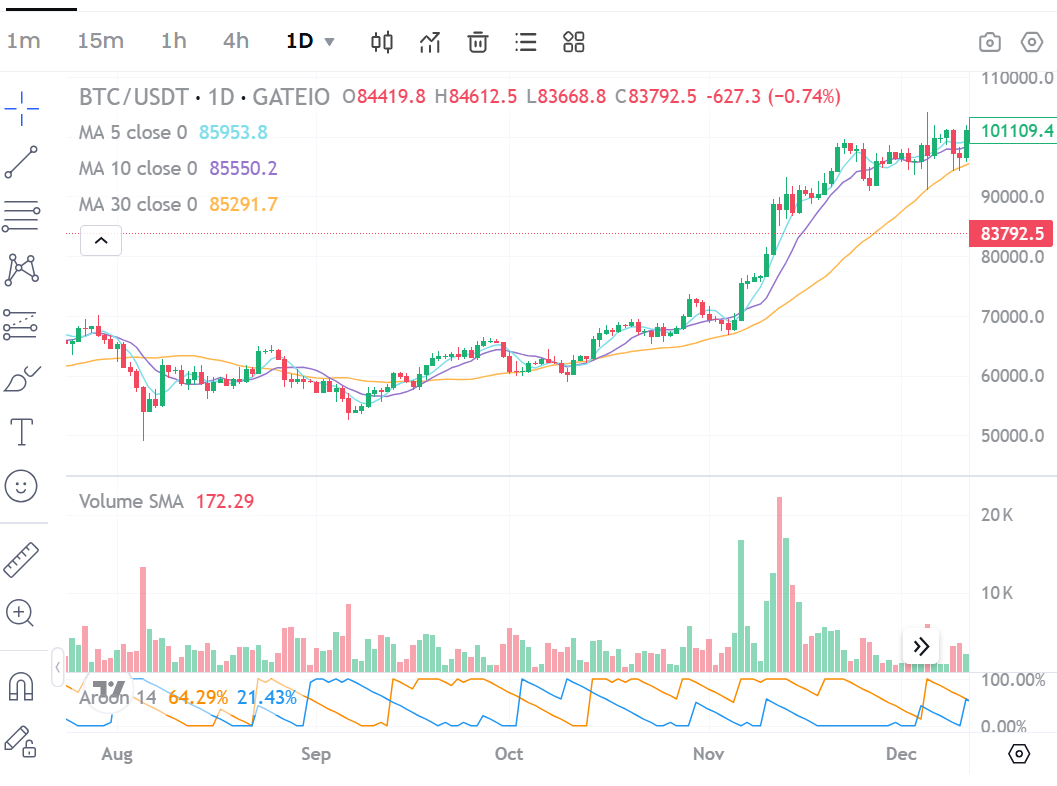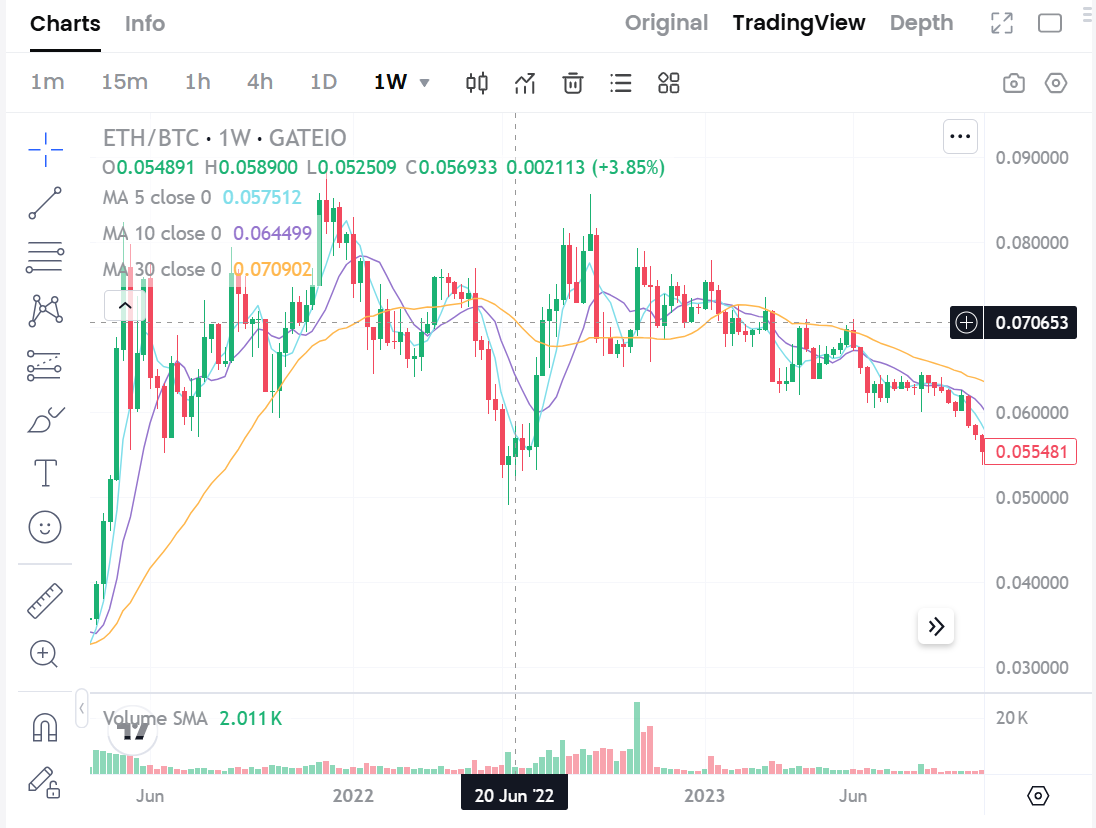Indicadores de Posicionamento das 10 Principais Altcoins
Introdução
Em meio às ondas do mercado de criptomoedas, as altcoins, como uma classe de ativos diversificada além do Bitcoin, estão gradualmente se tornando uma área-chave para investidores em busca de oportunidades emergentes. Com a evolução dos ciclos de mercado, as altcoins frequentemente demonstram potencial para maior valorização do que as criptomoedas convencionais durante fases específicas, especialmente durante o período crítico conhecido como a Temporada das Altcoins. A Temporada das Altcoins é um fenômeno único no mercado de criptomoedas, caracterizado pelo rali de Bitcoin, que leva o capital a fluir gradualmente do Bitcoin para várias altcoins. Essa entrada gera surtos de preços rápidos, criando uma febre de riqueza. No entanto, em meio a essa festa financeira, o desafio chave para todo investidor é como temporizar sua entrada precisamente.
Perante a complexidade e incerteza do mercado, os investidores assemelham-se a navegadores a navegar através do nevoeiro, precisando de um farol orientador. Os indicadores de posicionamento de altcoins servem como esse farol, perfurando a incerteza para revelar os padrões subjacentes do mercado e as oportunidades potenciais. Estes indicadores funcionam como instrumentos sofisticados, capturando a dinâmica do mercado a partir de múltiplas perspetivas. Seja tendências de preço, flutuações de volume de negociação ou mudanças subtis nos fluxos de capital, eles fornecem informações valiosas que ajudam os investidores a identificar pontos de entrada ótimos e aproveitar oportunidades em meio às ondas do mercado.
Este artigo irá apresentar os 10 principais indicadores de posicionamento de altcoin a partir de duas perspetivas: índices setoriais e índices de moedas individuais.
Primeiro, vamos avaliar a eficácia destes indicadores em diferentes fases do mercado de altcoins, incluindo a fase inicial, a fase principal de subida e a fase final.

Indicadores de Tendência do Setor de Altcoin
No mercado de criptomoedas, as altcoins, como uma classe de ativos diversificada para além do Bitcoin, requerem que os investidores monitorem de perto as tendências de mercado. Para capturar altcoins de alta qualidade, é crucial primeiro determinar se o mercado geral inclina-se para uma tendência de alta ou baixa. Abaixo, exploraremos em detalhe quatro indicadores-chave do setor:
Índice da Temporada de Altcoins
O Índice da Temporada de Altcoins mede o desempenho das altcoins (criptomoedas não relacionadas ao Bitcoin) no mercado. Ajuda os investidores a avaliar se as altcoins estão superando o Bitcoin durante um período específico, fornecendo insights sobre as tendências de mercado e oportunidades de investimento.
O Índice da Temporada de Altcoins é normalmente baseado nos seguintes fatores:
- Desempenho Relativo: Isto compara o desempenho do Bitcoin com as principais altcoins. Se a maioria das altcoins superar o Bitcoin, isso indica que o mercado entrou numa "Temporada de Altcoins."
- Dominância de Capitalização de Mercado: A dominância da capitalização de mercado do Bitcoin (Dominância do Bitcoin) é uma métrica de referência importante. Quando a dominância do Bitcoin diminui, muitas vezes sinaliza a entrada de capital em altcoins, o que poderia indicar o início de uma Temporada de Altcoins.
- Volume de Negociação e Volatilidade de Preços: O volume de negociação e as flutuações de preços das altcoins são indicadores importantes. Se o volume de negociação e os preços das altcoins dispararem enquanto o Bitcoin permanece relativamente estável, pode sugerir o início de uma Temporada de Altcoin.
- Mídias sociais e Sentimento da Comunidade: O nível de discussão nas redes sociais, cobertura de notícias e sentimento da comunidade também podem servir como indicadores suplementares. Um aumento de interesse e atenção para certas altcoins pode impulsionar seus preços para cima.
- Identificar Tendências de Mercado: Ao utilizar o Índice da Temporada Altcoin, os investidores podem determinar melhor se o mercado está numa fase dominante de Bitcoin ou numa Temporada Altcoin. Se o índice indicar um forte desempenho das altcoins, os investidores podem considerar realocar uma parte de seu capital do Bitcoin para as altcoins.

Origem: https://www.coinglass.com/pro/i/alt-coin-season
Dominância de Mercado do Bitcoin (BTC.D)
BTC.D representa a dominância de mercado do Bitcoin em todo o mercado de criptomoedas. Quando o BTC.D está alto, geralmente acima de 60%, a temporada do Bitcoin é dominante e as altcoins tendem a ter um desempenho inferior. Por outro lado, quando o BTC.D diminui, a liquidez gradualmente se desloca para as altcoins, muitas vezes sinalizando a chegada da Temporada de Altcoins. Por exemplo, se o BTC.D atingir um pico em um nível de resistência chave e começar a diminuir, isso serve como um sinal crucial de rotação de liquidez.

Origem: https://www.tradingview.com/markets/cryptocurrencies/dominance/
Desempenho Relativo do Ethereum vs. Bitcoin (ETH/BTC)
ETH/BTC é um dos gráficos mais importantes no mercado de criptomoedas. Quando o Ethereum tem um desempenho inferior ao do Bitcoin, as altcoins geralmente enfrentam dificuldades. Por outro lado, se o Ethereum se fortalecer e mantiver níveis-chave de suporte, muitas vezes indica uma potencial Temporada de Altcoin. Como um dos maiores participantes no ecossistema de criptomoedas, o desempenho do Ethereum influencia significativamente a tendência do mercado em geral.

Origem: https://www.Gate.com/pt-PT/trade/ETH_BTC
Indicadores de Seleção de Moedas Alternativas Individuais
Uma vez entendida a tendência mais ampla do setor de altcoins, os investidores devem concentrar-se nas moedas individuais. A transição dos indicadores de tendência do setor para os indicadores de moedas individuais baseia-se em duas considerações-chave: Enquanto as tendências gerais do mercado fornecem um pano de fundo macro, as decisões de investimento requerem uma análise em nível micro das altcoins individuais. Diferentes altcoins se comportam de maneira diferente ao longo dos ciclos de mercado - algumas se recuperam cedo devido às forças do projeto, enquanto outras ficam para trás devido a vários fatores, exigindo ferramentas analíticas mais detalhadas. Os indicadores de moedas individuais ajudam os investidores a identificar as altcoins mais promissoras dentro de uma tendência de setor confirmada, possibilitando decisões de investimento precisas. Esses indicadores se concentram no desempenho de mercado, estruturas técnicas, aspectos fundamentais do projeto e sentimento de mercado, todos os quais impactam diretamente a volatilidade de curto prazo e o valor de longo prazo de uma altcoin.
Média Móvel Simples (SMA)
O SMA calcula o preço médio ao longo de um período específico, oferecendo aos investidores uma visualização clara das tendências de preço. Os traders de curto prazo geralmente monitorizam o SMA de 5 dias ou 10 dias, enquanto os investidores de longo prazo frequentemente referenciam o SMA de 100 dias ou 200 dias. Quando o preço está acima do SMA, geralmente é considerado um sinal de alta; inversamente, se cair abaixo, pode indicar uma tendência de baixa. Este indicador atua como o 'pulso médio' do mercado, ajudando os investidores a compreender a direção geral do preço.

Origem: https://www.Gate.com/trade/ETH_USDT
Índice de Força Relativa (RSI)
O RSI é um oscilador de momentum que analisa a velocidade e a taxa de variação de preços para determinar se um ativo está sobrecomprado ou sobrevendido. Varia de 0 a 100, com leituras acima de 70 geralmente indicando condições de sobrecompra e abaixo de 30 sugerindo condições de sobrevenda. O RSI atua como o “termômetro de sentimento” do mercado, alertando os investidores para os potenciais riscos de reversão quando o mercado está superaquecido ou muito frio.

Origem: https://www.Gate.com/trade/ETH_USDT
Retração de Fibonacci
Com base na sequência de Fibonacci, este indicador marca os níveis de preço-chave acima e abaixo do preço de mercado atual, ajudando os traders a identificar possíveis níveis de suporte e resistência. Os níveis de retração mais comumente usados são 23,6%, 38,2%, 50%, 61,8% e 78,6%. A retração de Fibonacci funciona como a “proporção áurea” do mercado, revelando áreas cruciais onde os preços podem reverter ou enfrentar resistência, tornando-se uma ferramenta essencial para estratégias de entrada e saída.

Origem: https://www.Gate.com/trade/ETH_USDT
Convergência e Divergência de Médias Móveis (MACD)
O MACD é um indicador de momentum de seguimento de tendência que representa a diferença entre as médias móveis de curto e longo prazo de um ativo. É composto pela linha MACD, linha de sinal e histograma, que ajudam os traders a avaliar o momentum do mercado. O MACD atua como o "motor do movimento do mercado", com cruzamentos entre o MACD e as linhas de sinal ou formações específicas de histograma sinalizando possíveis mudanças no mercado.

Origem: https://www.Gate.com/trade/ETH_USDT
Oscilador Estocástico
O Oscilador Estocástico é um indicador de momento que utiliza o preço de fecho de um ativo para determinar condições de sobrecompra e sobrevenda. É frequentemente utilizado em conjunto com médias móveis para filtrar ruídos e melhorar a precisão do sinal. Atuando como o "detector de mercado microscópico", analisa a relação entre o preço de fecho e a sua gama de preços para revelar mudanças de momento a curto prazo.

https://www.Gate.com/trade/ETH_USDT
Nuvem Ichimoku
A Nuvem Ichimoku é uma ferramenta de análise técnica abrangente que inclui vários componentes, como a nuvem (Kumo), a linha líder (Senkou Span) e a linha base (Kijun Sen). Ajuda a determinar a direção da tendência, a força e as possíveis áreas de suporte/resistência. A Nuvem Ichimoku funciona como o "panorama do mercado", oferecendo aos investidores uma visão ampla das tendências e zonas de preço chave para melhor entender a estrutura geral do mercado.

Fonte: https://www.Gate.com/zh/trade/ETH_USDT
Indicador Aroon
O Indicador Aroon é uma ferramenta de acompanhamento de tendências que mede o tempo decorrido entre os máximos e mínimos mais altos para determinar a direção e força da tendência. É composto por linhas Aroon Up e Aroon Down, representando o tempo decorrido desde os preços mais altos e mais baixos dentro de um determinado período, respetivamente. O Indicador Aroon atua como a "bússola da tendência", ajudando os investidores a identificar se o mercado está em uma tendência de alta ou baixa.

Origem: https://www.Gate.com/trade/ETH_USDT
Métricas On-Chain
As métricas on-chain fornecem insights sobre a saúde fundamental e a atividade de uma criptomoeda ou token. Métricas on-chain comuns incluem a Relação de Valor de Rede para Transação (NVT), receita de mineradores e endereços ativos diariamente. Essas métricas ajudam a avaliar as tendências de mercado, a saúde geral e os movimentos de preço futuros potenciais. As métricas on-chain servem como o "relatório de verificação de saúde" do mercado, oferecendo aos investidores uma compreensão profunda das condições de mercado subjacentes e das tendências de crescimento potenciais com base em dados de blockchain.
Por exemplo, a métrica on-chain NVT (Network Value to Transaction Ratio) é um indicador que mede a relação entre o valor de mercado e a atividade de transação de criptomoedas. Compara a capitalização de mercado (Market Cap) com o volume diário de transações on-chain (Transaction Volume) para ajudar os investidores a avaliar a valoração relativa do mercado. A Glassnode é uma plataforma líder de dados e inteligência blockchain que fornece métricas abrangentes on-chain e financeiras, incluindo dados NVT. Os utilizadores podem aceder a dados NVT em tempo real e históricos através da sua plataforma para análise de tendências de mercado.
- Através da taxa NVT, os utilizadores podem observar o equilíbrio relativo entre estes dois componentes, com tendências e extremos fornecidos pelo seguinte quadro geral:
- Uma alta taxa NVT (ou tendência ascendente) indica que os investidores estão a precificar o Bitcoin em excesso, uma vez que a taxa de crescimento da capitalização de mercado excede o volume de transações on-chain e a utilização de valor de liquidação. Historicamente, os valores altos da taxa NVT coincidem com os topos de mercado e períodos de sobrevalorização.
- Uma taxa NVT mais baixa (ou tendência descendente) sugere que os investidores estão subavaliando o Bitcoin, pois o volume de transações on-chain e a utilização da rede excedem o crescimento da capitalização de mercado. Historicamente, valores mais baixos da taxa NVT são favoráveis para acumulação e normalmente estão alinhados com fundos de mercado e mercados em alta.
- Uma razão NVT constante (ou tendência lateral) indica que as tendências de crescimento da capitalização de mercado e do volume de transferência estão equilibradas, sugerindo que a tendência de mercado atual é sustentável. Este estado ocorre tipicamente nas fases iniciais a intermédias de uma tendência de mercado de alta ou baixa, quando a direção do mercado já está clara.

Origem: https://docs.glassnode.com/guides-and-tutorials/metric-guides/nvt/nvt-ratio
No investimento em moedas alternativas, esses indicadores de construção de posição têm cada um as suas próprias características e vantagens. Os investidores podem selecionar uma combinação adequada de indicadores com base no seu estilo de negociação e objetivos de investimento para melhorar a precisão e eficácia das decisões de investimento. Ao mesmo tempo, é importante notar que nenhum indicador é infalível; são apenas ferramentas para auxiliar na tomada de decisões. Os investidores também devem considerar fatores como fundamentos de mercado e notícias, e realizar uma análise abrangente e julgamento para navegar de forma constante no complexo mercado de criptomoedas e alcançar a preservação e valorização dos seus ativos.
Fluxograma de Seleção de Indicador Técnico
Para ajudar os investidores a compreender e aplicar melhor esses indicadores, o seguinte é um fluxograma simplificado para selecionar indicadores técnicos.

Origem: Gate.com
Validação da Combinação de Indicadores
No mercado de criptomoedas, um único indicador muitas vezes não é suficiente para prever com precisão as tendências de mercado. Portanto, os investidores normalmente combinam vários indicadores para uma análise abrangente, a fim de melhorar a precisão na tomada de decisões. Abaixo está um exemplo específico que mostra como confirmar um sinal de construção de posição quando a dominância de mercado do Bitcoin (BTC.D) cai abaixo de 45%, com base no desempenho relativo do Ethereum e do Bitcoin (ETH/BTC) no gráfico semanal e o índice de força relativa (RSI) do setor de altcoins tornando-se coletivamente sobrevendido.
- BTC.D cai abaixo de 45%: Tomando junho de 2022 como exemplo, neste momento, BTC.D estava em 48% e depois caiu abaixo de 45%.

Origem: https://www.tradingview.com/symbols/BTC.D
- Gráfico Semanal ETH/BTC Breakout: Observando o desempenho relativo do Ethereum e do Bitcoin (ETH/BTC) no gráfico semanal, por volta de 20 de junho, o gráfico claramente tocou o fundo e mostrou um rebote. Isso indicou que a temporada de altcoins havia chegado.

Origem: https://www.Gate.com/trade/ETH_BTC
- Setor de Altcoin RSI a ser sobrevendido: Tomando LTC como exemplo, neste momento, a linha de tendência RSI para LTC era de 33,16, indicando uma condição de sobrevenda. Com base nos indicadores BTC.D e ETH/BTC, podemos considerar isto como um sinal de construção de posição. Olhando para o gráfico semanal, se uma posição for construída neste ponto, o preço verá um aumento de mais de 100% em algumas semanas.

Fonte: https://www.Gate.com/trade/LTC_USDT
Análise de Risco e Gestão de Posição
Análise Típica de Caso de Risco
Em maio de 2021, criptomoedas mainstream como Bitcoin (BTC) e Ethereum (ETH) atingiram máximos históricos. No entanto, o sentimento de mercado começou a mudar e alguns investidores começaram a realizar lucros, levando a sinais de uma correção de mercado.
Durante este mês, as plataformas de monitorização on-chain detetaram um grande número de grandes transações. Estas transações ocorreram principalmente entre grandes exchanges de criptomoedas, indicando que uma quantidade significativa de fundos estava a sair das exchanges. Este movimento de capital é frequentemente visto como um sinal de aviso de que o mercado está prestes a declinar, pois pode sugerir que grandes detentores (como investidores institucionais ou baleias) estão a vender as suas posições.
À medida que as transferências de grandes montantes aumentaram, o preço de mercado começou a experimentar declínios significativos. O preço do Bitcoin caiu de quase $60,000 para cerca de $30,000, uma diminuição de mais de 50%. O mercado de altcoins também foi severamente impactado, com muitas altcoins perdendo mais de 70% do seu valor. Essa flutuação de preço acentuada causou pânico no mercado, e muitos investidores sofreram perdas significativas em um curto período de tempo.
Este evento destaca a importância da monitorização de dados on-chain na gestão de riscos. Ao monitorizar de perto as grandes transferências on-chain, os investidores podem captar prontamente mudanças no sentimento de mercado e ajustar as suas estratégias de investimento para minimizar possíveis perdas. Além disso, serve como um lembrete para os investidores permanecerem cautelosos nos máximos de mercado e evitarem perseguir cegamente os preços.
Cenários de Falha de Indicadores e Estratégias de Cobertura
Cenários de Falha do Indicador
Em altcoins de baixa liquidez, uma cruz da morte (onde a média móvel de curto prazo cruza abaixo da média móvel de longo prazo) pode produzir mais sinais falsos. Devido ao baixo volume de negociação dessas moedas, os preços são mais suscetíveis a grandes transações, o que faz com que os indicadores gerem sinais de venda falsos.
Análise de caso: Por exemplo, uma altcoin sofre uma grande venda a curto prazo, fazendo com que a média móvel a curto prazo caia abaixo da média móvel a longo prazo, formando uma cruz da morte. No entanto, essa venda pode ser um comportamento a curto prazo de uma baleia individual, em vez de uma mudança na tendência geral do mercado. Se os investidores se basearem unicamente no sinal da cruz da morte para vender, podem perder a subsequente recuperação de preços.
Pânico no Mercado Levando a Falha do Indicador: Durante vendas de pânico no mercado, muitos indicadores técnicos podem falhar. Por exemplo, o Índice de Força Relativa (RSI) pode mostrar condições de sobrevenda, mas o preço ainda pode continuar a cair porque o sentimento de mercado está dominando o movimento de preço.
Incerteza nas Políticas Macroeconómicas: Alterações nas políticas governamentais (como proibições de negociação de criptomoedas ou políticas regulatórias mais rigorosas) podem levar a fortes flutuações de mercado, fazendo com que os indicadores técnicos percam o seu valor de referência. Por exemplo, em 2021, a proibição da negociação de criptomoedas na China levou a um acentuado declínio do mercado, durante o qual muitos indicadores técnicos falharam.
Estratégias de Gestão de Risco
- Definir Pontos de Stop-Loss
Operação: Os investidores devem definir claramente os pontos de stop-loss para cada posição de investimento para limitar as perdas potenciais. Por exemplo, vender automaticamente ativos quando o preço cai por um certo percentual.
Efeito da Gestão de Risco: Os pontos de stop-loss ajudam os investidores a sair do mercado de forma oportuna quando as condições são desfavoráveis, evitando mais perdas.
- Reavaliar regularmente estratégias
Operação: Os investidores devem reavaliar regularmente a eficácia das suas estratégias de investimento e indicadores, ajustando a sua carteira com base nas mudanças de mercado. Por exemplo, rever a carteira a cada trimestre para garantir que esteja alinhada com o ambiente de mercado atual.
Efeito da Gestão de Risco: Avaliações regulares garantem a oportunidade e eficácia das estratégias de investimento, evitando que as estratégias se tornem ineficazes devido a mudanças no mercado.
Correlação Entre Regras de Stop-Loss e Sinais de Indicadores
- BTC.D Quebra de Suporte Chave: Quando a dominância do mercado do Bitcoin (BTC.D) rompe um nível de resistência chave, isso pode indicar uma mudança no sentimento de mercado. Os investidores devem considerar a redução de suas posições em altcoins e realocar fundos para ativos mais estáveis. Por exemplo, no final de janeiro de 2025, BTC.D quebrou um nível de resistência chave e logo depois, os preços das altcoins registraram uma queda significativa em comparação com o BTC.

Origem: https://www.tradingview.com/symbols/BTC.D/
- Quebra Semanal Chave do ETH/BTC: Se o gráfico semanal relativo do Ethereum em relação ao Bitcoin quebrar um nível de suporte chave, isso pode ser um sinal forte de venda, indicando uma potencial reversão de tendência de mercado. Os investidores devem considerar parar e sair do mercado.

Origem: https://www.Gate.com/trade/ETH_BTC
- Setor de Altcoins RSI Sobrevendido: Quando o indicador RSI do setor de altcoins excede coletivamente 70, sugere que o mercado está em um estado de sobrecompra e os preços podem em breve corrigir. Os investidores devem considerar a redução de suas posições para evitar possíveis perdas de uma reversão de mercado.

Fonte: https://www.Gate.com/trade/LTC_USDT
Tomando LTC como exemplo, em 5 de dezembro de 2024, o valor do RSI atingiu 78,82 e o preço posteriormente caiu mais de 30%.
Conclusão
Nas ondas complexas do mercado de criptomoedas, as altcoins, como uma classe de ativos diversificada fora do Bitcoin, estão gradualmente a tornar-se uma área importante para os investidores perseguirem tendências e descobrirem potencial. Através dos 10 principais indicadores de entrada de altcoin introduzidos neste artigo, os investidores podem obter uma compreensão abrangente da dinâmica do mercado, desde tendências macro até à seleção individual de moedas micro, permitindo a identificação precisa de oportunidades de entrada. Nenhum indicador é infalível; são apenas ferramentas para auxiliar na tomada de decisões. Ao utilizar estes indicadores, os investidores devem combinar análise de mercado fundamental, fatores de notícias e outros aspetos para uma avaliação abrangente. Apenas assim podem mover-se de forma estável no complexo mercado de criptomoedas, preservando e aumentando os seus ativos.
Artigos relacionados

Como Aposta ETH

Utilização de Bitcoin (BTC) em El Salvador - Análise do Estado Atual

O que é Solana

O que é a Dogecoin?

O que é o Gate Pay?
